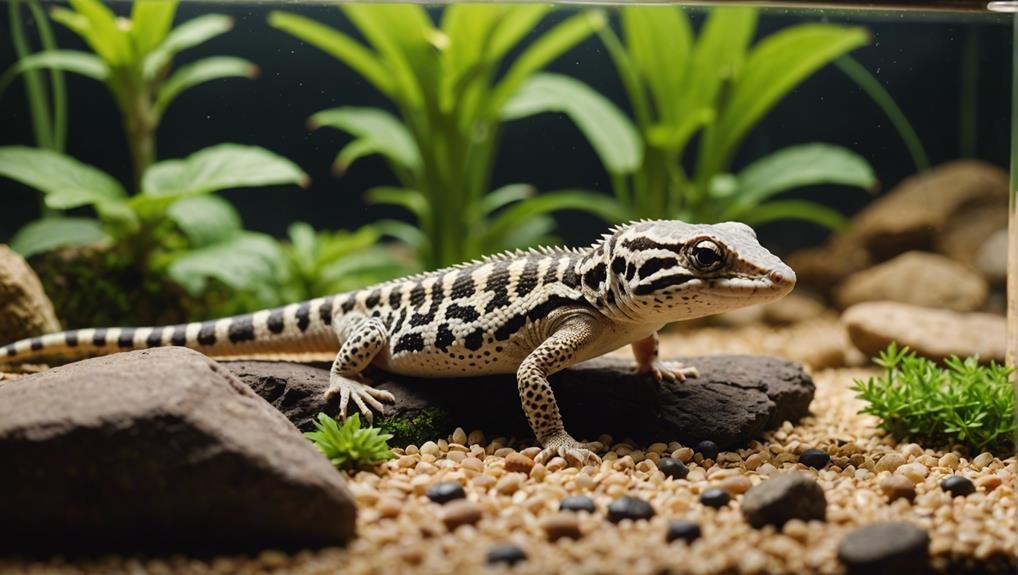When setting up a leopard gecko tank, you must consider several vital elements to guarantee your pet thrives. Start with a minimum tank size of 10 gallons, though larger tanks offer more enrichment. Focus on tank material, ventilation, and substrate choice to establish a healthy environment. Lighting and temperature gradients are essential for their well-being, while humidity management ensures comfort. Don’t forget to add hides and decorations to mimic their natural habitat. Are you wondering how to balance these factors for an ideal setup? Let’s explore each element to create the perfect home for your gecko.
Key Takeaways
- Use a minimum 10-gallon tank, preferably 15-20 gallons, for optimal enrichment and temperature gradient.
- Choose a tank with proper ventilation, like mesh or wire lids, to ensure healthy airflow.
- Provide safe substrates like an organic topsoil and play sand mix, avoiding pure sand to prevent impaction.
- Maintain a temperature gradient with a basking area at 90-92°F and night temperatures in the low 70s°F.
- Include at least two hides, one moist for shedding, rocks, and wood pieces for climbing and shelter.
Tank Size
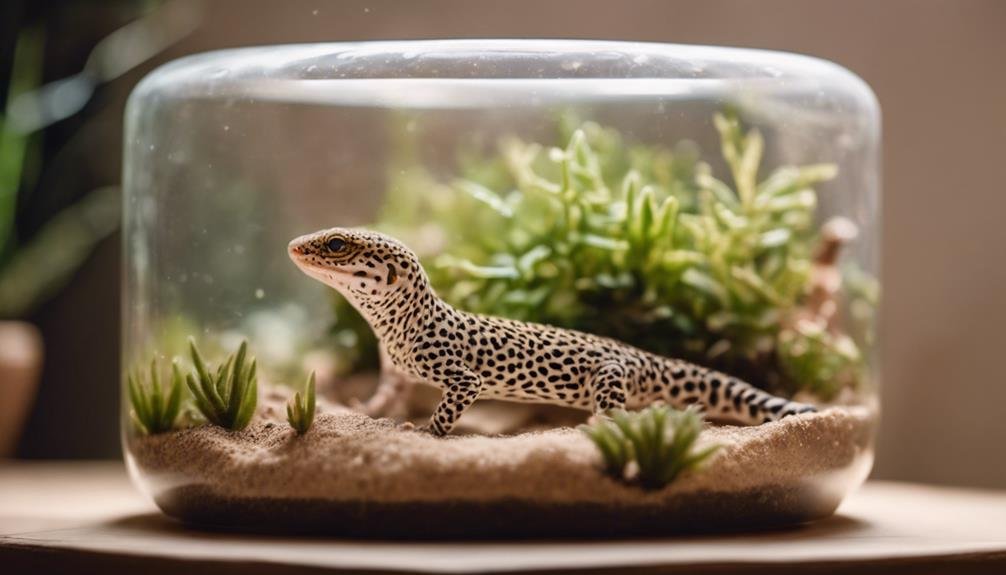

How do you choose the right tank size for your leopard gecko?
It starts with understanding that a 10-gallon tank is the minimum recommended size.
However, if you can opt for larger tanks, such as 15 or 20 gallons, you’ll provide your gecko with more space for enrichment and exercise. This additional room is important for their well-being.
Think about the tank’s dimensions:
A longer and wider tank is better suited for leopard geckos than a tall one. This design allows ample space for essential items like hides, climbing structures, and a proper temperature gradient, which is necessary for creating a stimulating and comfortable environment.
When setting up the tank, ensure enough space to accommodate multiple hides.
Leopard geckos need different hides to feel secure and regulate their body temperature effectively. Adding climbing structures also promotes exercise, helping to keep your gecko active and healthy.
A larger tank also makes it easier to establish a temperature gradient.
This gradient allows your gecko to move between warmer and cooler areas as needed. Choosing the right tank size is ultimately about providing a balanced environment that meets your leopard gecko’s needs.
Tank Material
When choosing a tank material for your leopard gecko, glass tanks are often the best option due to their high visibility and ease of cleaning. Glass tanks allow you to easily observe your gecko’s behavior and maintain a clean and hygienic environment. They are generally durable and promote good airflow, which is essential for your pet’s health.
Plastic tanks are another option known for their durability. However, some plastic tanks can be opaque, which limits visibility. This makes it harder to monitor your gecko and spot any potential issues. If you opt for a plastic tank, ensure it has clear sides for better visibility.
Wooden terrariums can be a more affordable choice, but they require a waterproof coating to prevent moisture damage. While they can provide decent insulation, proper ventilation is vital to maintaining good airflow.
Whether glass, plastic, or wooden, front-opening tanks are highly recommended for easy access and cleaning. This feature makes it convenient to feed your gecko, clean the tank, and arrange decorations.
Here’s a quick comparison to help you decide:
| Tank Material | Visibility | Durability |
|---|---|---|
| Glass Tanks | High | High |
| Plastic Tanks | Variable | High |
| Wooden Terrariums | Moderate | Moderate |
Tank Ventilation
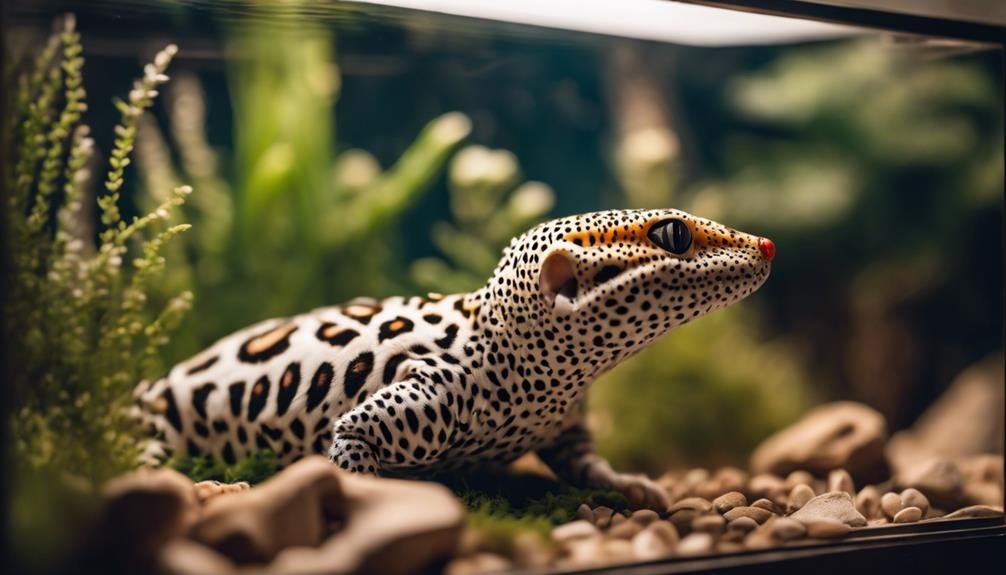

Beyond selecting the right tank material, ensuring proper tank ventilation is essential for your leopard gecko’s health and well-being. Adequate ventilation helps maintain appropriate airflow, which is vital to prevent respiratory issues in your pet. By incorporating sufficient ventilation, you can also regulate humidity levels within the tank, creating a comfortable and healthy environment for your gecko.
One effective way to achieve this is using mesh or wire lids on the tank. These lids allow for sufficient airflow while keeping your leopard gecko secure. Without adequate tank ventilation, stagnant air can build up, leading to mold growth and potentially severe health problems for your gecko. Monitoring and ensuring proper ventilation can help prevent these issues and maintain a safe and comfortable living space.
Pay attention to the signs of improper ventilation. If you notice condensation inside the tank or a musty smell, it indicates that the airflow isn’t sufficient. Address these issues promptly to safeguard your leopard gecko’s health.
Substrate
Selecting the appropriate substrate for your leopard gecko’s tank is crucial for their health and happiness. The substrate supports their natural digging and burrowing behavior and helps mimic their natural habitat. However, you should be cautious about the type of substrate you choose to avoid impaction risks, which can harm your gecko.
Consider a mix of 70% organic topsoil and 30% play sand for a safe and effective loose substrate. This combination allows for ideal digging opportunities while minimizing the risk of impaction. Aim for a substrate depth of 4-6 inches to give your gecko ample space to dig and burrow.
Alternatively, using paper towels as a substrate is a great option for the first three months. This makes monitoring your gecko’s health and waste easier and ensures there are no underlying health issues.
Here are some key points to remember:
- Avoid unsafe substrates: Loose materials like pure sand can pose serious impaction risks.
- Organic topsoil and play sand mix: A 70/30 mix offers a safe and natural environment.
- Substrate depth: 4-6 inches is ideal for digging and burrowing behavior.
- Paper towels: Use them initially for easier health monitoring.
Lighting
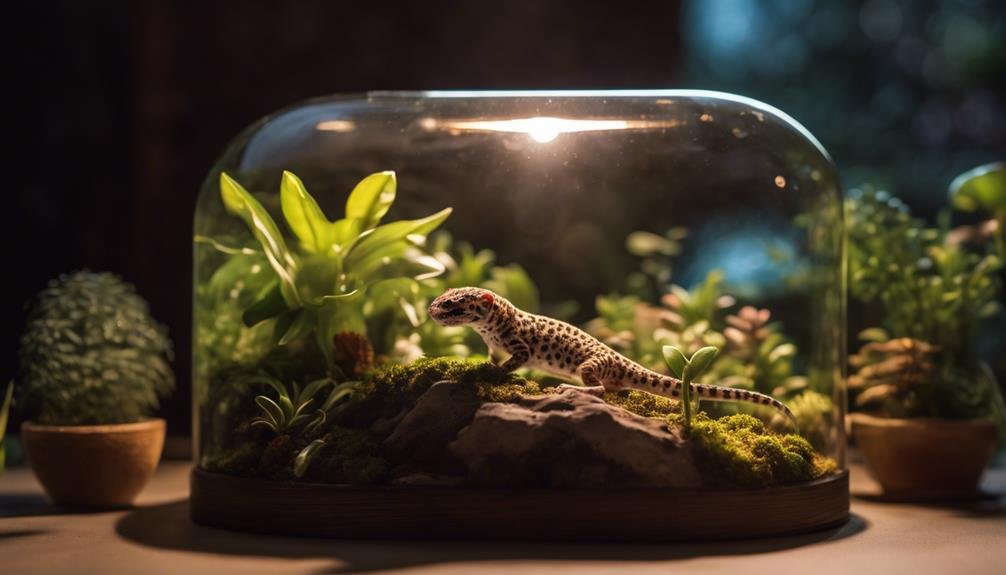

After setting up the perfect substrate, it’s time to focus on the lighting needs for your leopard gecko tank. Unlike many reptiles, leopard geckos don’t require special UV lighting because they’re nocturnal and don’t need UVB for calcium metabolism. However, providing the right light and heat is essential for mimicking their natural habitat and maintaining their health.
Daylight or basking bulbs are excellent choices for providing necessary heat and light during the day. These bulbs help maintain a proper circadian rhythm, which is vital for your gecko’s overall well-being. Halogen bulbs can also be a good option, as they offer consistent heat without overly drying the tank environment.
While it might be tempting to use colored lights at night, they can disrupt your leopard gecko’s natural day/night cycle, so it’s best to avoid them. Instead, let the tank remain dark at night to simulate their natural habitat.
Grab basking bulbs; here’s the link:
https://www.amazon.com/dp/B09RSQWB9Y?tag=mus0a-21
Temperature
Maintaining the appropriate temperature gradient in your leopard gecko’s tank is crucial for their health and well-being. Ensure your tank setup includes both a hot and cool side, allowing your gecko to thermoregulate effectively. The hot side should be around 88-90°F during the day, with a basking area reaching 90-92°F for proper digestion and activity. At night, the temperature can drop to the low 70s°F to mimic natural conditions.
To achieve this temperature gradient, consider the following steps:
- Heat Source: A heat lamp or an under-tank heater creates the hot side. Ensure it covers only a portion of the tank for a cooler area.
- Digital Thermometer: To monitor temperatures accurately, place a digital thermometer on both the hot side and the cool side.
- Thermostats: Regulate the temperature with thermostats to prevent overheating or chilling, ensuring a consistent environment.
- Tank Setup: Position your basking area directly under the heat source, ensuring it reaches the necessary 90-92°F for proper Leopard Gecko Care.
Humidity
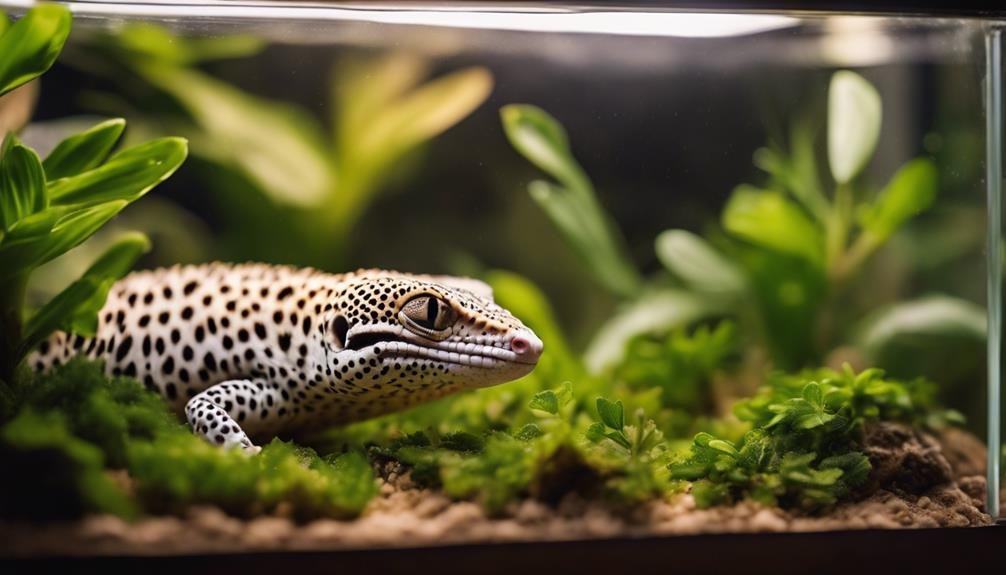

Maintaining humidity between 20% and 40% in your leopard gecko’s tank is crucial for their overall health and well-being. Leopard geckos originate from arid environments, so proper humidity levels are important in preventing various health issues. Use a digital hygrometer to monitor these levels accurately.
Low humidity can lead to shedding issues, such as retained shed skin, which can cause discomfort and potential infections. To guarantee your gecko sheds properly, provide a humid hide filled with moist substrate. This creates a microenvironment with higher humidity where your gecko can retreat when they need extra moisture.
You can easily increase humidity in the tank by misting the enclosure lightly or placing a water dish inside. However, avoid over-misting to prevent excessively high humidity, which can also be harmful.
Regularly check the digital hygrometer to confirm the tank stays within the ideal range. If you notice the humidity levels dropping too low, add moisture by misting or adjusting the water dish immediately. Maintaining appropriate humidity levels will help your leopard gecko thrive and avoid common health issues with low humidity.
Hides
Every leopard gecko tank requires at least two hides to guarantee your pet feels secure and comfortable. These hides are essential retreats where your gecko can manage stress and find refuge.
To provide your gecko with ideal living conditions, follow these guidelines:
- Temperature Options: Place one hide on the warm side of the tank and another on the cool side. This setup allows your gecko to regulate its body temperature effectively.
- Moist Hide: Adding an important hide is crucial. It helps maintain proper humidity levels, which is particularly important during shedding.
- Comfort and Security: Ensure each hide is appropriately sized, allowing your gecko to fit comfortably without feeling cramped. This promotes a sense of security.
- Proper Placement: Position hides in various locations within the tank to offer diverse microenvironments, enhancing your gecko’s ability to regulate its body temperature and overall well-being.
Decorations
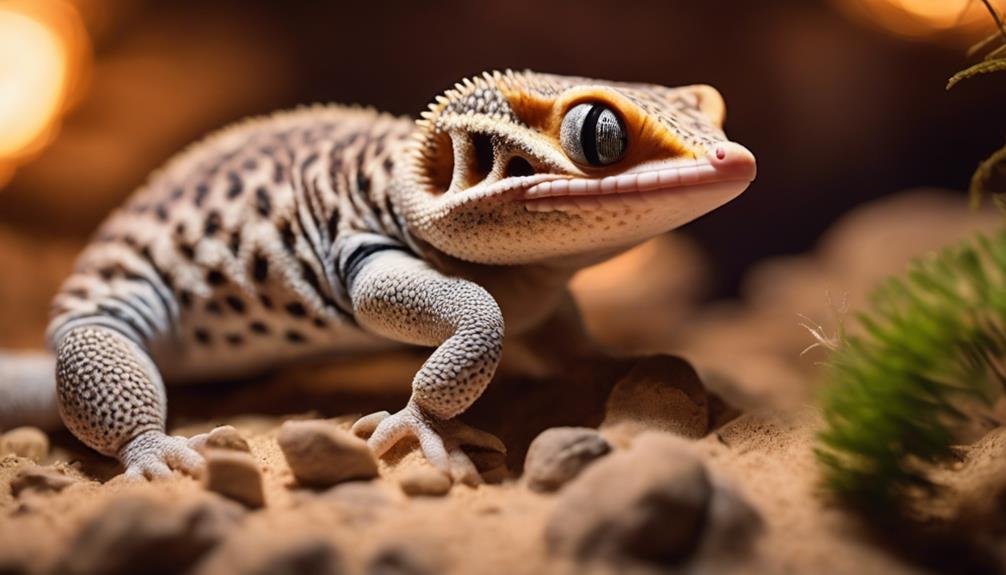

Once you’ve established the hides, it’s time to enhance your leopard gecko’s tank with decorations that provide enrichment and functional benefits.
Start by adding rocks, which can create natural shelter and climbing surfaces. Choose smooth, flat stones like slate, which offer excellent grip for your gecko. Secure these rocks with non-toxic glue to prevent shifting and potential injuries.
Incorporate wood pieces into the tank setup for added texture and climbing opportunities. Ensure the wood is free from pests and chemicals and arrange it to complement the tank’s overall layout.
A 3D rock background can greatly enhance the tank’s aesthetic appeal while providing extra climbing surfaces for your gecko. These backgrounds mimic natural environments and promote physical activity, contributing to your pet’s overall enrichment.
You can also use climbing backgrounds to create vertical elements in the tank. These backgrounds offer an additional layer of engagement, ensuring your gecko remains stimulated. However, avoid making multiple levels to prevent falls and injuries.
Essential Accessories
To guarantee a thriving environment for your leopard gecko, you must include essential accessories in the tank setup. These accessories support your gecko’s health and enhance their overall well-being. Here’s a list of must-have items that leopard gecko owners should consider:
- Hides: Leopard geckos need multiple hides to provide extra security and reduce stress. Place one on the warm side and another on the cool side of the tank to allow your gecko to regulate its body temperature.
- Lighting and Heating: While leopard geckos are nocturnal, proper lighting is still important. Use basking lights or UVB bulbs to help prevent metabolic bone disease. Thermometers and thermostats are essential to monitor and regulate temperature levels.
- Food and Water Dishes: Shallow food and water dishes are ideal for easy access. Make sure they’re cleaned regularly to prevent bacterial growth. Including a calcium dish ensures your gecko receives essential nutrients for bone health.
- Substrate: Choose a safe substrate to support your geckos’ movement and avoid impaction. Paper towels or reptile carpets are good options.
Conclusion
By carefully considering tank size, materials, and ventilation, you can ensure that your leopard gecko has a comfortable home.
Choose the right substrate, provide proper lighting, and manage humidity to create a healthy environment.
Don’t forget to include hides and decorations for enrichment and essential accessories like thermometers and hygrometers.
With these elements in place, your gecko will thrive in a safe and stimulating habitat.
You’ve got this!
Related Articles:
https://thereptileguide.com/leopard-gecko-death-roll-enigma-syndrome-seizures-2/
https://thereptileguide.com/what-do-leopard-geckos-eat-2/

